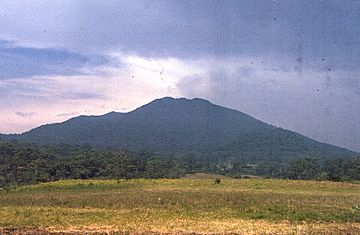San Martin Tuxtla facts for kids
Quick facts for kids San Martin Tuxtla |
|
|---|---|
 |
|
| Highest point | |
| Elevation | 1,650 m (5,410 ft) |
| Geography | |
| Geology | |
| Mountain type | Shield Volcano |
| Last eruption | 1794 to 1796 |
The San Martin Tuxtla volcano is a special kind of volcano called a shield volcano. It stands tall near the Gulf of Mexico in Veracruz, Mexico. This volcano is part of a group of volcanoes known as the Tuxtla volcanic field.
San Martin Tuxtla has erupted several times in the past. Its lava is made of different types of rock, like basanite and alkali basalt. Local people also call this volcano Tiltépetl. This name means "Black mountain" in the Nahuatl language.
Contents
About San Martin Tuxtla
San Martin Tuxtla is a large, wide volcano. It looks like a warrior's shield lying on the ground. This is why it is called a shield volcano. It reaches a height of about 1,680 meters (5,510 feet).
At the very top of the volcano, there is a large crater. This crater is about 1 kilometer (0.6 miles) wide. It is also about 150 meters (490 feet) deep. Inside this main crater, there are two smaller cones. These cones were the source of a big eruption in 1793.
The sides of San Martin Tuxtla are covered with many smaller volcanic hills. There are about 250 of these smaller cones and maars. Some of these have also erupted in the past. Today, the volcano is covered in thick forests.
Past Eruptions
San Martin Tuxtla has a history of eruptions. Here are some of the most notable ones:
1664 Eruption
In 1664, a large eruption happened on the southeast side of the volcano. This was a powerful eruption, rated as a VEI 3. A VEI (Volcanic Explosivity Index) number tells us how big an eruption was. Because of this eruption, people living nearby had to leave their homes for safety.
1793 Eruption
Another big eruption took place in 1793. This one was even stronger, rated as a VEI 4. The eruption came from the two small cones inside the main crater at the top. It sent a lot of ash into the air, which fell over a wide area. Lava flows also moved down the northeast side of the volcano.
1794-1796 Eruption
A smaller eruption began in May 1794. This eruption continued for about two years, until 1796. It was rated as a VEI 2. Even though it was smaller, it lasted for a long time.
Images for kids
See also




